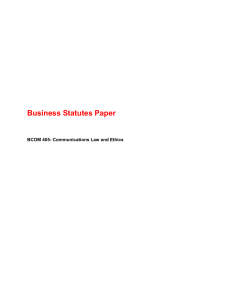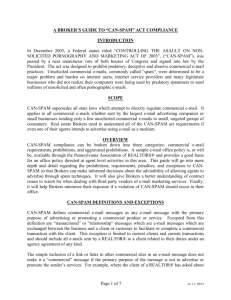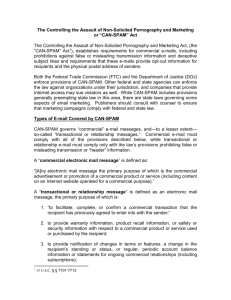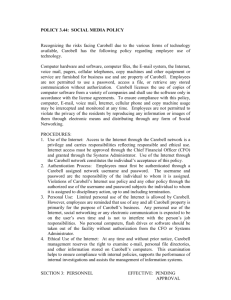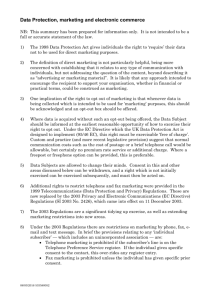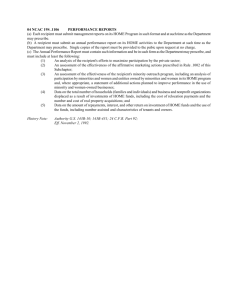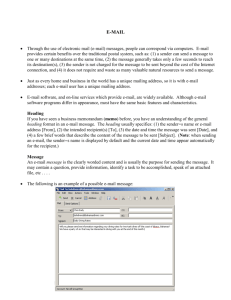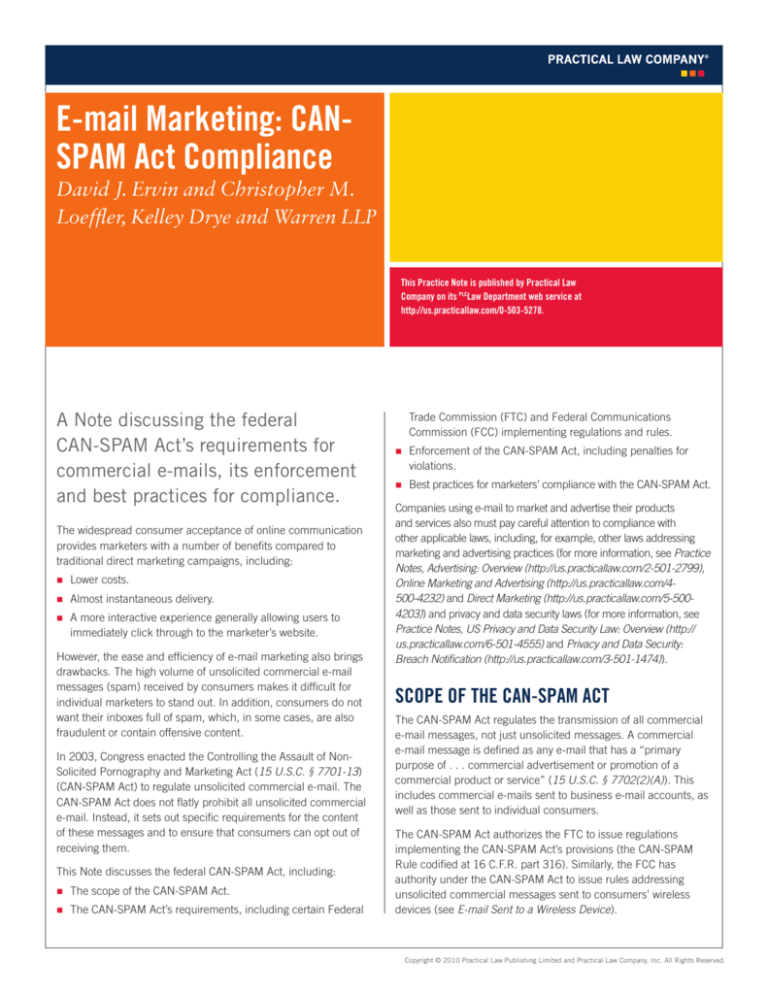
E-mail Marketing: CANSPAM Act Compliance
David J. Ervin and Christopher M.
Loeffler, Kelley Drye and Warren LLP
This Practice Note is published by Practical Law
Company on its PLCLaw Department web service at
http://us.practicallaw.com/0-503-5278.
A Note discussing the federal
CAN-SPAM Act’s requirements for
commercial e-mails, its enforcement
and best practices for compliance.
The widespread consumer acceptance of online communication
provides marketers with a number of benefits compared to
traditional direct marketing campaigns, including:
Lower
costs.
Almost
instantaneous delivery.
A
more interactive experience generally allowing users to
immediately click through to the marketer’s website.
However, the ease and efficiency of e-mail marketing also brings
drawbacks. The high volume of unsolicited commercial e-mail
messages (spam) received by consumers makes it difficult for
individual marketers to stand out. In addition, consumers do not
want their inboxes full of spam, which, in some cases, are also
fraudulent or contain offensive content.
In 2003, Congress enacted the Controlling the Assault of NonSolicited Pornography and Marketing Act (15 U.S.C. § 7701-13)
(CAN-SPAM Act) to regulate unsolicited commercial e-mail. The
CAN-SPAM Act does not flatly prohibit all unsolicited commercial
e-mail. Instead, it sets out specific requirements for the content
of these messages and to ensure that consumers can opt out of
receiving them.
This Note discusses the federal CAN-SPAM Act, including:
The
scope of the CAN-SPAM Act.
The
CAN-SPAM Act’s requirements, including certain Federal
Trade Commission (FTC) and Federal Communications
Commission (FCC) implementing regulations and rules.
Enforcement
of the CAN-SPAM Act, including penalties for
violations.
Best
practices for marketers’ compliance with the CAN-SPAM Act.
Companies using e-mail to market and advertise their products
and services also must pay careful attention to compliance with
other applicable laws, including, for example, other laws addressing
marketing and advertising practices (for more information, see Practice
Notes, Advertising: Overview (http://us.practicallaw.com/2-501-2799),
Online Marketing and Advertising (http://us.practicallaw.com/4500-4232) and Direct Marketing (http://us.practicallaw.com/5-5004203)) and privacy and data security laws (for more information, see
Practice Notes, US Privacy and Data Security Law: Overview (http://
us.practicallaw.com/6-501-4555) and Privacy and Data Security:
Breach Notification (http://us.practicallaw.com/3-501-1474)).
SCOPE OF THE CAN-SPAM ACT
The CAN-SPAM Act regulates the transmission of all commercial
e-mail messages, not just unsolicited messages. A commercial
e-mail message is defined as any e-mail that has a “primary
purpose of . . . commercial advertisement or promotion of a
commercial product or service” (15 U.S.C. § 7702(2)(A)). This
includes commercial e-mails sent to business e-mail accounts, as
well as those sent to individual consumers.
The CAN-SPAM Act authorizes the FTC to issue regulations
implementing the CAN-SPAM Act’s provisions (the CAN-SPAM
Rule codified at 16 C.F.R. part 316). Similarly, the FCC has
authority under the CAN-SPAM Act to issue rules addressing
unsolicited commercial messages sent to consumers’ wireless
devices (see E-mail Sent to a Wireless Device).
Copyright © 2010 Practical Law Publishing Limited and Practical Law Company, Inc. All Rights Reserved.
E-mail Marketing: CAN-SPAM Act Compliance
IS IT A COMMERCIAL MESSAGE?
Messages
Containing Only Advertising Content. These
messages have a commercial primary purpose.
A first step in evaluating whether the CAN-SPAM Act applies
to an e-mail message is to determine whether the e-mail is a
commercial message. Not every e-mail message from a business
is deemed a commercial message under the CAN-SPAM Act.
Rather, the e-mail’s primary purpose must be the commercial
advertisement or promotion of a product or service.
Messages
Containing Both Advertising and Transactional or
Relationship Content. These messages have a commercial
primary purpose if either:
The
recipient would interpret the subject line to mean that
the message contains commercial advertising.
A
substantial part of the transactional or relationship content
does not appear at the beginning of the message.
In particular, messages sent to consumers that have a primary
purpose relating to a particular transaction or relationship
between the sender and the consumer are expressly exempted
from the CAN-SPAM Act’s specific requirements for commercial
messages (15 U.S.C. § 7702(2)(B)). To qualify as a transactional
or relationship message, the e-mail’s primary purpose must be to
do one or more of the following:
Messages
Containing Both Advertising Content and Other
Non-transactional or Non-relationship Content. These
messages have a commercial primary purpose if either:
The
recipient would interpret the subject line to mean that
the message contains commercial advertising.
Facilitate,
complete or confirm a commercial transaction
previously agreed to by the e-mail recipient.
The
recipient would determine from the body of the
message that the message’s primary purpose is commercial
advertising.
Provide
warranty, product recall, safety or security information
for a product purchased by the e-mail recipient.
In making this determination, factors for the recipient to
consider include:
Provide
certain information permitted under the CAN-SPAM
Act regarding a subscription, membership, account, loan or
similar ongoing relationship concerning the e-mail recipient’s
ongoing purchase or use of the sender’s products or services
(for example, notification of a change in terms or features of
a membership or subscription or periodic account information).
the
placement of the commercial advertising at the
beginning of the message;
the
proportion of the message dedicated to commercial
advertising; and
Provide
information regarding an employment relationship or
related benefit plan in which the e-mail recipient is currently
involved, participating or enrolled.
how
prominent the commercial advertising is (for example,
highlighted through use of graphics type size and style).
Messages
Containing only Transactional or Relationship
Content. These messages do not have a commercial primary
purpose (see also Is it a Commercial Message?).
Deliver
goods or services (for example, updates or upgrades)
that the e-mail recipient is entitled to receive as a result of a
previously agreed upon transaction.
(16 C.F.R. § 316.3.)
(15 U.S.C. § 7702(17)(A).)
If the message includes content only in one or more of the
above categories, it is not a commercial message under the
CAN-SPAM Act. If a message contains both transactional or
relationship content and commercial content, the CAN-SPAM
Act’s commercial e-mail requirements apply if the message’s
primary purpose is commercial (see Is the Message’s Primary
Purpose Commercial?).
WHO MUST COMPLY WITH THE CAN-SPAM ACT?
Initiators of Commercial E-mail Messages
Any person, including business entities and nonprofit
associations, that initiates commercial e-mail messages must
comply with the CAN-SPAM Act requirements (see Can-Spam Act
Requirements). As defined by the CAN-SPAM Act, a person is an
“initiator” of a commercial e-mail message if it either:
The CAN-SPAM Act also contains compliance obligations and
prohibitions for transactional or relationship messages (see
Prohibition on False or Misleading Transmission Information),
but these are less rigorous than the rest of the requirements
specific to commercial messages (see generally, Commercial
Message Requirements).
Originates
Procures
the transmission of the e-mail, meaning that
the business either intentionally pays or provides other
consideration to, or induces, another person to transmit the
e-mail on its behalf.
IS THE MESSAGE’S PRIMARY PURPOSE COMMERCIAL?
The CAN-SPAM Act contains an exception, however, when the
person initiating the commercial e-mail is involved solely in
routine conveyance. This is when the person’s actions only relate
to the transmission, routing or storage of the message through
an automatic technical process and the person is not involved in
identifying or providing the recipients’ addresses for the message.
Even if the e-mail does include some commercial content, the
CAN-SPAM Act’s commercial e-mail requirements apply only
if the message’s primary purpose is commercial. The FTC
has clarified the analysis to determine a message’s primary
purpose as follows:
Copyright © 2010 Practical Law Publishing Limited and Practical Law Company, Inc. All Rights Reserved.
or transmits the e-mail.
2
Senders of Commercial E-mail Messages
technical problem beyond the sender’s control, it is not a violation
of the CAN-SPAM Act’s opt-out requirements if the problem is
corrected within a reasonable time (15 U.S.C. § 7704(a)(3)(C)).
Certain other requirements apply specifically to “senders” (see
Opt-Out Requirements and Other Requirements). A sender is
an initiator whose own product or service, or internet website,
is advertised or promoted in the commercial message. A
commercial e-mail can have more than one initiator or sender. For
example, where a business engages a third-party service provider
to send a commercial e-mail advertising the business’s products,
both parties are initiators under the CAN-SPAM Act. The business
is also a sender under the CAN-SPAM Act.
A sender of a commercial e-mail cannot require the recipient to
do any of the following to submit (or have the sender honor) an
opt-out request when using any of the opt-out methods required
by the CAN-SPAM Act:
Pay
a fee.
Provide
any information other than the recipient’s e-mail
address and opt-out preferences.
For specific issues involving determining whether a person is
an initiator or sender under the CAN-SPAM Act, see Common
Marketing Practices: “Forward-to-a-Friend” E-mails, Multiple
Senders and Affiliate Marketing.
Take
any steps other than sending a reply message or visiting a
single website.
(16 C.F.R. § 316.5.)
If the message recipient submits a request to opt out of receiving
future message from a sender, all of the following apply:
CAN-SPAM ACT REQUIREMENTS
The
opt out must become effective within 10 business days.
After this time, the sender (or anyone on its behalf) may not send
further commercial e-mail messages falling within the scope
of the opt-out request to that recipient, unless the recipient
subsequently requests to receive (opts in) these messages.
PROHIBITION ON FALSE OR MISLEADING TRANSMISSION
INFORMATION
It is a violation of the CAN-SPAM Act to initiate the transmission of
a commercial message or a transactional or relationship message
that contains false or misleading transmission information, which
is an e-mail’s “From,” “To,” “Reply to” and routing information
(also known as the header information). Instead, this information
must be correct and identify the person initiating the message (15
U.S.C. § 7704(a)(1)).
The
opt out never expires.
The
sender (and any other person that knows the recipient
has opted out of further commercial messages) cannot sell,
exchange or otherwise transfer the recipient’s e-mail address
except as required by law unless that recipient has explicitly
opted in to permitting the sale, exchange or transfer.
COMMERCIAL MESSAGE REQUIREMENTS
(15 U.S.C. § 7704(a)(3)-(5)(A)(i)-(iv).)
Prohibition on Deceptive Subject Headings
Other Requirements
The CAN-SPAM Act prohibits a person from initiating a commercial
e-mail with a deceptive subject heading. This means that the initiator
of the message cannot have actual knowledge (or knowledge fairly
implied under the circumstances) that the subject heading would
be likely to mislead the recipient about a material fact regarding the
message’s contents or subject matter (15 U.S.C. § 7704(a)(1)).
Initiators of a commercial e-mail must also include following
elements in each commercial e-mail:
Clear
identification that the message is an advertisement or
solicitation.
The
sender’s valid physical postal address. This is typically the
sender’s street address, but can also be post office box that the
business has accurately registered with the US Postal Service
or a private mailbox that the business has accurately registered
with a commercial mail receiving agency established pursuant
to US Postal Service regulations.
Opt-out Requirements
The CAN-SPAM Act requires initiators of a commercial e-mail to
include following elements in each commercial e-mail:
Clear
notice of the recipient’s right to not receive (opt out of)
future messages from the sender of the e-mail.
One
(15 U.S.C. § 7704(a)(3)-(5)(A)(i)-(iii).)
of the following mechanisms for opting out:
SEXUALLY ORIENTED MATERIAL
a
functional return e-mail address, allowing the recipient to
simply “reply” to the e-mail indicating the recipient’s opt out; or
The CAN-SPAM Act and the FTC’s related rules set out additional
restrictions on initiators of commercial e-mails containing sexually
oriented material. These restrictions relate to the e-mail’s:
another
internet-based opt-out mechanism (for example, a link
to a separate web page containing the opt-out mechanism).
The opt-out mechanism must be functional for at least 30 days
after the message is sent. If the return e-mail address or other
mechanism, however, is unexpectedly and temporarily unable to
receive messages or process opt-out requests resulting from a
Subject
line (see Message Subject Line).
Content
(see Message Content).
These restrictions do not apply, however, if the e-mail recipient has given
prior affirmative consent to receive these messages from the sender.
3
Copyright © 2010 Practical Law Publishing Limited and Practical Law Company, Inc. All Rights Reserved.
E-mail Marketing: CAN-SPAM Act Compliance
The CAN-SPAM Act defines sexually oriented material as any
material that “depicts sexually explicit conduct . . . unless the
depiction constitutes a small and insignificant part of the whole”
where the remaining content is not primarily devoted to sexual
matters (15 U.S.C. § 7704(d)(4)).
typically sent using one of two methods:
A
web-based mechanism provided by the business that originally
sent or provided the content (either in an e-mail or on a website).
Using
the consumer’s own e-mail program.
Message Content
When using forward-to-a-friend e-mails as a marketing tool, a
business must determine whether it is an initiator or sender of
these messages under the CAN-SPAM Act (see Who Must Comply
with the CAN-SPAM Act?). If the web-based mechanism merely
provides a method for a recipient to forward the message along to
a friend, or if the recipient forwards the message using a personal
e-mail program, absent more, the originator is not likely the initiator
of the forwarded message and is not subject to the CAN-SPAM
Act. In this case, the business’s role would probably be considered
solely routine conveyance. Where the recipient forwards the
message using a personal e-mail program, without consideration or
inducement, the business likely is not involved at all.
To prevent recipients from being exposed unintentionally to
sexually oriented material in a commercial message, the FTC rule
also limits the content that can be initially visible by a recipient
using the electronic equivalent of a “brown paper wrapper.” The
content of these messages must only contain:
The FTC has clarified that a business’s use of language merely
encouraging a consumer to forward a message to a friend does
not, without more, subject the business to the CAN-SPAM Act’s
requirements for senders of commercial e-mails (see FTC’s
discussion at 73 Fed. Reg. 29654, 29671).
Message Subject Line
The FTC’s Adult Labeling Rule requires that the:
Subject
line of a commercial e-mail not contain any sexually
oriented material.
The
phrase “SEXUALLY-EXPLICIT: “ appears in capital letters
as the first 19 characters in the subject line of any commercial
e-mail message that contains sexually oriented material.
(16 C.F.R. § 316.4(a).)
The
phrase “SEXUALLY-EXPLICIT: “.
If the business “procures” the forwarded message, however,
the business is considered to be the initiator or sender, and the
commercial message must comply with the CAN-SPAM Act.
A business can procure the forwarding of a message through
several actions, including by either:
The
same required information as other commercial e-mails,
including:
Clear
and conspicuous identification that the message is an
advertisement or solicitation.
Clear
notice of the recipient’s ability to opt out of receiving
future messages and a valid opt-out mechanism (either a
functioning return e-mail address or other internet-based
mechanism) that remains operational for no less than 30
days after the e-mail was sent.
Offering
the recipient money, coupons, discounts, awards,
additional entries in a sweepstakes or similar consideration for
forwarding the message.
Intentionally
inducing the recipient to forward the message,
for example, by paying a marketing affiliate (see Affiliate
Marketing) who in turn uses sub-affiliates, to send commercial
messages to drive traffic to the business’s website. Although no
direct relationship between the business and the sub-affiliate
exists, if the business intentionally induces the forwarding of
the commercial messages through the affiliate, it is considered
to be the sender.
The
sender’s valid physical postal address, clearly and
conspicuously displayed.
Any
necessary instructions identifying how the recipient may
access the sexually oriented material. If the e-mail includes
these instructions, the instructions must come after a clear
and conspicuous statement that to avoid viewing the sexually
oriented material, a recipient should delete the message
without following the instructions.
MULTIPLE SENDERS
(16 C.F.R. § 316.4(a)(2).)
The FTC rules also clarify CAN-SPAM Act requirements when
a single e-mail contains commercial messages from multiple
senders (73 Fed. Reg. 29654, 29655).
COMMON MARKETING PRACTICES:
“FORWARD-TO-A-FRIEND” E-MAILS,
MULTIPLE SENDERS AND AFFILIATE
MARKETING
When multiple businesses’ products or services, or internet websites,
are advertised or promoted in a single message, each business is
a sender for purposes of CAN-SPAM Act compliance, unless the
businesses have designated a single sender of the commercial
message by complying with all of the following requirements:
“FORWARD-TO-A-FRIEND” E-MAILS
The
single business meets the CAN-SPAM Act’s definition of
“sender.” This is the person that both initiates the message and
whose products or services, or internet websites are advertised
or promoted in the message.
Marketers use a common practice to enable recipients of a
commercial e-mail to forward the message (or a similar one) to
one or more friends. These “Forward-to-a-Friend” e-mails are
Copyright © 2010 Practical Law Publishing Limited and Practical Law Company, Inc. All Rights Reserved.
4
E-MAIL SENT TO A WIRELESS DEVICE
The
single business is identified in the “From” line as the sole
sender of the message.
The
The FCC is authorized by the CAN-SPAM Act to regulate
communication to wireless devices and has enacted certain
regulations addressing certain commercial messages sent to
wireless devices (47 C.F.R. § 64.3100).
single business is in compliance with the:
prohibition
on false or misleading transmission information;
prohibition
on deceptive subject headings;
requirement
to include a functioning opt out;
In contrast to the general opt-out requirements set out in the CANSPAM Act and FTC rules, the FCC has prohibited the sending
of commercial messages to certain e-mail addresses provided
by wireless carriers specifically for mobile messaging services,
for example, “customer@wirelesscompany.com” (referred to as
mobile service commercial messages), unless the subscriber gives
express prior authorization (opts in), which can be written or oral.
requirement
to include clear and conspicuous identification
that the message is an advertisement or solicitation, a clear
and conspicuous notice of the opportunity to opt out, and a
valid physical postal address of the sender; and
requirement
to include warning labels on commercial e-mail
that contains sexually oriented material.
(16 C.F.R. § 316.2(m)) (see also Commercial Message
Requirements and Sexually Oriented Material).
Specifically, the FCC maintains a list of domain names for
wireless messaging services posted on its website (http://www.
fcc.gov/cgb/policy/DomainNameDownload.html). Wireless
carriers are required to update this list periodically. Unless a
recipient has given express prior authorization, a person must
not initiate commercial e-mail to any address with a domain
name that has been on the list for at least 30 days before the
message is sent, or otherwise knowingly initiate a mobile service
commercial message.
In this instance, only the designated sender must comply with
the CAN-SPAM Act’s requirements for senders, including the
obligation to scrub against any opt-out lists maintained by the
sender and honoring opt-out requests. Only the designated
sender’s valid physical postal address must appear in the
message. If the above requirements are not complied with, each
business must comply with the CAN-SPAM Act’s requirements
for senders (including the obligation to scrub against all of the
senders’ opt-out lists).
When requesting express prior authorization, an initiator of a
mobile service commercial message must, among other things:
Even where a single sender is designated, the other businesses will be
deemed initiators of the commercial e-mail for CAN-SPAM purposes.
Clearly
state the identity of the entity that will be sending the
messages.
Notify
the subscriber that he may be charged by the wireless
carrier for receipt of these messages.
AFFILIATE MARKETING
A commercial e-mail can have more than one initiator or sender
(see Who Must Comply with the CAN-SPAM Act?). Companies
often engage third-party affiliate marketers to increase traffic to
the company’s website. These affiliates are typically paid based on
the number of individuals who, directed by the affiliates, ultimately
visit the business’s website or make a purchase on the website.
Disclose
(47 C.F.R. § 64.3100(d).)
Once a recipient expressly authorizes these messages, similar to
the FTC’s rules for commercial messages, any person initiating a
mobile service commercial message must include:
FTC has brought several claims against both companies whose
product or service was advertised in the commercial e-mail as
well as the affiliate that sent the message. In these situations, the
company is deemed the sender of the commercial e-mail. The
affiliate, who typically originates or transmits the e-mail message,
is an initiator. If the affiliate also advertises its own services or
products, it is also a sender under the CAN-SPAM Act and the
rules concerning multiple senders apply (see Multiple Senders).
Clear
notice of the recipient’s ability to opt out of receiving
future messages from the sender of the e-mail.
A
clearly and conspicuously displayed functional return e-mail
address or internet-based method for the subscriber to opt out.
A sender must stop sending further messages within 10 days after
receiving an opt-out request. Like the FTC’s rules, the opt-out
methods must be functional for at least 30 days after the message
was sent.
A company also may be liable for violations of the CAN-SPAM
Act’s prohibition on false or misleading transmission information
(see Prohibition on False or Misleading Transmission Information)
by a marketing affiliate or other third party promoting the
company’s business or its products or services if the company:
Knows
(or should have known) of the violations.
Profits
from the prohibited practice.
Fails
that the subscriber can revoke his authorization at any
time.
In addition, the FCC rule requires that where recipients have
electronically provided express prior authorization (for example, by
dialing a short code) they must be able to opt-out of future e-mails
by the same electronic method. The initiator of the message must
also ensure that at least one opt-out option is provided that does
not result in additional charges to the mobile service subscriber.
to stop or report the violations.
(15 U.S.C. § 7705(a).)
(47 C.F.R. § 64.3100(b).)
5
Copyright © 2010 Practical Law Publishing Limited and Practical Law Company, Inc. All Rights Reserved.
E-mail Marketing: CAN-SPAM Act Compliance
ENFORCEMENT AND PENALTIES FOR NONCOMPLIANCE
STATE ENFORCEMENT
The CAN-SPAM Act authorizes state attorneys general, officials
and other agencies to bring claims for CAN-SPAM Act violations
against residents of that state. These state agencies can seek:
Although the FTC is the primary enforcer of the CAN-SPAM Act, the
CAN-SPAM Act also allows various federal, state and private parties to
bring claims for violations. Penalties for non-compliance vary based on:
Injunctive
relief.
Damages
for actual loss or statutory damages up to $250
per violation, whichever is greater, with a maximum award of
$2,000,000. Each separately addressed unlawful message
is treated as a separate violation. Notably, claims for false or
misleading headers (see Prohibition on False or Misleading
Subject Headers) are not limited by this cap.
The
party bringing the claim, for example, the FTC, the FCC
and other federal agencies, state attorneys general and private
actions brought by internet service providers (as described in
more detail below).
Whether
the violation was willful, knowing or aggravated (see
also Aggravated Violations).
Three
times the amount of statutory damages for willful,
knowing or aggravated violations (see also Aggravated
Violations).
FTC ENFORCEMENT
The FTC has authority to enforce the CAN-SPAM Act as if a
violation were an unfair or deceptive act or practice prohibited
under the Federal Trade Commission Act. The FTC can seek civil
penalties for CAN-SPAM Act violations as if they were violations of
trade regulation rules. This includes:
Costs
Civil
Internet service providers (ISPs) are authorized to bring claims
under the CAN-SPAM Act for certain violations (for example,
violations of the prohibition on false or misleading transmission
information or the requirement to place warning labels for sexually
oriented material) and may seek:
(15 U.S.C. § 7706(f).)
INTERNET SERVICE PROVIDER CLAIMS
penalties up to $16,000 for each separate e-mail that
violates the CAN-SPAM Act (if based on actual knowledge or
knowledge fairly implied).
Injunctive
relief (even without a showing of knowledge).
(15 U.S.C. § 7706(a), (d), (e).)
Injunctive
relief.
Actual
damages or statutory damages for false or misleading
headers up to $100 per violation, whichever is greater, with no
limitation on the maximum award.
ENFORCEMENT BY OTHER AGENCIES
Certain other agencies have authority under the CAN-SPAM Act
to enforce it. These agencies generally regulate certain types of
entities or activities outside the scope of the FTC’s jurisdiction.
Penalties for non-compliance are determined by the regulatory
regime enforced by the specific agency (15 U.S.C. § 7706(b)).
These agencies include:
For
all other violations, actual damages or statutory damages of
up to $25 per violation, whichever is greater, with a maximum
award of $1,000,000.
Three
times the amount of statutory damages for willful,
knowing or aggravated violations (see also Aggravated
Violations).
The
Office of the Comptroller of the Currency, the Federal
Reserve Board, the Federal Deposit Insurance Corporation
Board of Directors and the Director of the Office of Thrift
Supervision under the Federal Deposit Insurance Act.
Costs
of bringing the action and reasonable attorneys’s fees.
Each separately addressed unlawful message is treated as a
separate violation. Where an ISP is bringing a claim, the term
“procure” for purposes of initiating a commercial e-mail message
((see Who Must Comply with the CAN-SPAM Act?) requires that
the person providing consideration or inducing another person to
initiate the e-mail transmission has actual knowledge, or should
have known, that the person transmitting the e-mail is engaging, or
will engage, in a pattern of practice violating the CAN-SPAM Act.
The
Board of the National Credit Union Administration, enforcing
the CAN-SPAM Act under the Federal Credit Union Act.
The
Securities and Exchange Commission, enforcing the CANSPAM Act under the Securities Exchange Act of 1934, the
Investment Company Act of 1940 and the Investment Advisors
Act of 1940.
State
insurance authorities, enforcing the CAN-SPAM Act
under state insurance laws.
(15 U.S.C. § 7706(g).)
The
Secretary of Transportation, enforcing the CAN-SPAM Act
under the US Code’s air commerce and safety provisions (49
U.S.C. §§ 40101-40129).
FCC CLAIMS
The CAN-SPAM Act authorizes the FCC to bring claims for
violations of its rule regarding the sending of commercial e-mail
to wireless devices (see E-mail Sent to a Wireless Device). If
the action is brought against a telecommunications provider
(a common carrier), the FCC can seek up to $150,000 per
The
Secretary of Agriculture, enforcing the CAN-SPAM Act
under the Farm Credit Act of 1971.
The
FCC, enforcing the CAN-SPAM Act under the
Communications Act of 1934.
Copyright © 2010 Practical Law Publishing Limited and Practical Law Company, Inc. All Rights Reserved.
of bringing the action and reasonable attorney fees.
6
Address
Harvesting. The automatic capturing of e-mail
addresses posted to websites including social networking sites,
blogs, newsgroups, message boards and chat rooms.
violation with a maximum of $1,500,000 per incident. If the
action is brought against a marketer who is generally not a
common carrier and therefore not subject to FCC jurisdiction,
the FCC may first issue a citation. If additional claims are
brought against a marketer that previously received a citation,
the FCC can seek fines up to $16,000 per violation with a
maximum of $112,500 per incident.
Dictionary
Attacks. The automated process of creating
possible name combinations that may be valid e-mail
addresses.
Spoofing.
The relay or retransmission of e-mail messages
through another computer that is accessed without
authorization.
The FCC can also bring claims for other violations of the CAN-SPAM
Act (not just for commercial e-mails sent to wireless devices) against
entities subject to its jurisdiction, for example, telecommunications
providers or marketers advertising telecommunications products (see
Enforcement by Other Agencies).
Automated
Creation of Multiple E-mail Accounts. The
automatic creation of a large number of e-mail accounts so that
those accounts may be used to send commercial e-mail.
While these are not considered separate violations, if a party
commits an aggravated violation along with a violation of the
requirements for commercial messages or sexually oriented
material (see Commercial Message Requirements and Sexually
Oriented Material), the party may be liable for enhanced statutory
damages of up to three times the damages.
VIOLATIONS RELATING TO SEXUALLY ORIENTED MATERIAL
Knowing violations of the CAN-SPAM Act’s restrictions on commercial
e-mails containing sexually oriented material includes fines and
imprisonment of up to five years (15 U.S.C. § 7704(d)(5)).
OTHER CRIMINAL PENALTIES
(15 U.S.C. § 7704(b).)
In addition to criminal penalties associated with knowing violations
of the rules for commercial e-mails containing sexually oriented
material (see Sexually Oriented Material), the CAN-SPAM Act also
carries criminal penalties for fraud and related activities.
PREEMPTION AND REMAINING CAUSES OF
ACTION
The federal CAN-SPAM Act preempts any state laws expressly
regulating commercial e-mail messages, except to the extent that
these laws generally prohibit false or deceptive acts or practices
(such as states’ general consumer protection laws) (15 U.S.C. §
7707(b)(1)).
Enforced by the Department of Justice and state attorneys
general, violations subject to criminal penalties include:
Accessing
a computer without authorization and using it to
intentionally initiate multiple commercial e-mail messages.
Relaying
or transmitting multiple commercial e-mail messages
intending to deceive or mislead recipients or an ISP about the
messages’ origin.
Although state laws generally are preempted by the CAN-SPAM
Act, Congress has attempted to create a balance by permitting
state attorneys general to bring claims under the CAN-SPAM Act
for violations affecting residents in their states (see Enforcement
and Penalties for Non-compliance).
Materially
falsifying header information in multiple commercial
e-mails and intentionally initiating these messages’ transmission.
Using
materially false identifying information to register for five
or more e-mail accounts or two or more domain names, and
intentionally initiating multiple commercial e-mail messages
from any combination of these accounts or domain names.
Additionally, the CAN-SPAM Act expressly does not preempt state
laws that are
Not
Falsely
representing oneself as the registrant of five or more
Internet Protocol addresses and intentionally initiating the
transmission of multiple commercial e-mail messages from
those addresses.
specific to e-mail, including trespass, contract, or tort law.
Related
to fraudulent or deceptive acts or computer crimes.
(15 U.S.C. § 7707(b)(2).)
Criminal penalties may include:
Fines.
Forfeiture
of assets.
Imprisonment
up to five years.
(18 U.S.C. § 1037.)
AGGRAVATED VIOLATIONS
The following four specific practices are aggravated violations
under the CAN-SPAM Act:
7
Copyright © 2010 Practical Law Publishing Limited and Practical Law Company, Inc. All Rights Reserved.
E-mail Marketing: CAN-SPAM Act Compliance
BEST PRACTICES FOR E-MAIL MARKETING
Practical tips for CAN-SPAM Act compliance are set out
below.
zzdo
anything more than reply to the e-mail or visit a
single web page to opt out;
REQUIREMENTS FOR ALL COMMERCIAL MESSAGES
The Mailing List
zzmake
any payment or submit any personal information,
including account information (other than e-mail
address), to opt out; and
The opt-out mechanism must work for at least 30 days
after the e-mail is sent.
The
mailing list should include only persons who have
affirmatively agreed (opted in) to receive commercial e-mail
from the business. While this is not a legal requirement
under the CAN-SPAM Act, it is an industry best practice.
Ensure
that the explanation of how a recipient can opt out
is easy to read and understand.
The
mailing list must not include any recipient who has
previously asked not to receive commercial e-mail from
the business (opted out).
The
business may include a menu of opt-out options that
permit the recipient to select the types of commercial
messages the recipient would like to continue receiving.
However, one option must permit opting out of all
commercial messages from the business.
Scrub
the mailing list against the business’s “do not
e-mail” list at the last possible, commercially reasonable
moment before the e-mail is sent.
Honor
The E-mail Message
requests do not expire. An opt-out is overridden
only by the recipient’s subsequent express (opt in) request
to receive commercial e-mail.
The
message must include complete and accurate
transmission and header information.
Do
not sell, share or use the business’s opt-out list for any
reason other than to comply with the law.
The
“From” line must identify the business as the sender.
This does not have to include the business’s formal name.
For example, it may contain the business’s name, trade
name or product or service name. The key requirement
is that the “From” line provide the recipient with enough
information to understand who is sending the message.
Monitoring Opt-out Capabilities
The business should implement procedures to ensure that
its opt-out capabilities actually work. An example of a basic
procedure to test the opt-out procedure is as follows:
The
“Subject” line must accurately describe the
message’s content.
Establish
e-mail accounts with several major private
e-mail account providers (for example, Gmail, Yahoo,
Hotmail, AOL, and so on) and add these e-mail addresses
to the business’s mailing list.
The
message must clearly include the business’s valid,
current physical postal address. This address can be a:
zzstreet
address;
For
each e-mail address created for monitoring purposes,
use the business’s opt-out mechanism to remove the
e-mail address from the mailing list.
zzpost
office box that the business has accurately
registered with the US Postal Service; or
Repeat
this procedure on a regular basis (for example, at
least every two weeks).
zzprivate
mailbox that the business has accurately
registered with a commercial mail receiving agency
established pursuant to US Postal Service regulations.
Examine
the e-mail received by the monitoring e-mail
account to confirm that the:
The
message must disclose that it is an advertisement
or solicitation unless the e-mail message is sent only to
recipients who have affirmatively agreed (opted in) to
receive these messages from the business.
zzopt-out
mechanism works;
zzopt-out
request is honored within 10 business days;
and
The Opt-out Mechanism
zzmonitoring
e-mail account no longer receives
commercial messages from the business.
The
message must clearly explain that the recipient may
opt out of receiving future commercial messages from the
business.
If
the monitoring and testing process reveals problems,
the business should immediately fix the issues.
Third-party Marketing Affiliates or Service Providers
The
message must include either an e-mail address
or other online mechanism that the recipient may use
for this opt out. The mechanism must not require the
recipient to:
Copyright © 2010 Practical Law Publishing Limited and Practical Law Company, Inc. All Rights Reserved.
all opt-out requests within ten business days.
Opt-out
When using third-party service providers, including affiliate
marketers:
8
BEST PRACTICES FOR E-MAIL MARKETING
(CONTINUED)
Practical Law Company provides practical legal
know-how for law firms, law departments and law
schools. Our online resources help lawyers practice
efficiently, get up to speed quickly and spend more
time on the work that matters most. This Article is
just one example of the many resources Practical
Law Company offers. Discover for yourself what the
world’s leading law firms and law departments use
to enhance their practices.
Ensure
that the written contract with the service
provider clearly sets out each party’s responsibilities
for compliance with the CAN-SPAM Act and includes
appropriate and adequate remedies for noncompliance.
Monitor
their compliance with the CAN-SPAM Act.
Both the company whose product or service is
advertised as well as the individual or entity sending
the message are potentially liable for violations of the
CAN-SPAM Act.
Contact Us
ADDITIONAL REQUIREMENTS FOR MESSAGES SENT
TO WIRELESS DEVICES
Practical Law Company
747 Third Avenue, 36th Floor
New York, NY 10017
646.562.3405
plcinfo@practicallaw.com
www.practicallaw.com
When sending commercial messages to wireless devices:
Ensure
that you have the recipient’s prior, affirmative
consent (opt in) to send the commercial message. The
consent can be oral, written or electronic.
Ask
for consent in a way that involves no cost to the
recipient, for example:
zzdo
not send the request to the wireless device; and
zzallow
the recipient to respond in a way that
involves no cost (such as an online, e-mail or
postal mail sign-up).
When
seeking consent, make it clear that the
recipient:
zzis
agreeing to receive commercial e-mail on his
wireless device;
zzmay
zzcan
12-10
be charged to receive the e-mail; and
revoke his consent at any time.
9
Copyright © 2010 Practical Law Publishing Limited and Practical Law Company, Inc. All Rights Reserved.
Use of PLC websites and services is subject to the Terms of Use (http://us.practicallaw.com/2-383-6690)
and Privacy Policy (http://us.practicallaw.com/8-383-6692).

